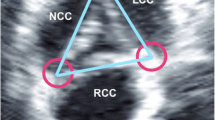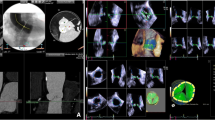Abstract
Aortic valve area is one of the main criteria used by echocardiography to determine the degree of valvular aortic stenosis, and it is calculated using the continuity equation which assumes that the flow volume of blood is equal at two points, the aortic valve area and the left ventricular outflow tract (LVOT). The main fallacy of this equation is the assumption that the LVOT area which is used to calculate the flow volume at the LVOT level is circular, where it is often an ellipse and sometimes irregular. The aim of this review is to explain the physiology of the continuity equation, the different sources of errors, the added benefits of using three-dimensional imaging modalities to measure LVOT area, the latest recommendations related to valvular aortic stenosis, and to introduce future perspectives. A literature review of studies comparing aortic valve area and LVOT area, after using three-dimensional data, has shown underestimation of both measurements when using the continuity equation. This has more impact on patients with discordant echocardiographic measurements when aortic valve area is disproportionate to haemodynamic measurements in assessing the degree of aortic stenosis. Although fusion imaging modalities of LVOT area can help in certain group of patients to address the issue of aortic valve area underestimation, further research on introducing a correction factor to the conventional continuity equation might be more rewarding, saving patients additional tests and potential radiation, with no clear evidence of cost-effectiveness.






Similar content being viewed by others
References
Baumgartner H, Hung J, Bermejo J, et al. Recommendations on the echocardiographic assessment of aortic valve stenosis: a focused update from the European Association of Cardiovascular Imaging and the American Society of Echocardiography. J Am Soc Echocardiogr. 2017;30(4):372–92.
Zoghbi WA, Farmer KL, Soto JG, et al. Accurate noninvasive quantification of stenotic aortic valve area by Doppler echocardiography. Circulation. 1986;73(3):452–9.
Pedlosky J. Geophysical fluid mechanics. New York: Springer-Verlag; 1987.
Gorlin R, Gorlin SG. Hydraulic formula for calculation of the area of the stenotic mitral valve, other cardiac valves, and central circulatory shunts. Am Heart J. 1951;41(1):1–29.
Chambers JB, Sprigings DC, Cochrane T, et al. Continuity equation and Gorlin formula compared with directly observed orifice area in native and prosthetic aortic valves. Heart. 1992;67(2):193–9.
Clavel M-A, Malouf J, Messika-Zeitoun D, et al. Aortic Valve area calculation in aortic stenosis by CT and Doppler echocardiography. JACC. 2015;8(3):248–57.
Clavel M-A, Burwash IG, Mundigler G, et al. Validation of conventional and simplified methods to calculate projected valve area at normal flow rate in patients with low flow, low gradient aortic stenosis: the multicenter TOPAS (true or pseudo severe aortic stenosis) study. J Am Soc Echocardiogr. 2010;23(4):380–6.
Monin J-L, Quéré J-P, Monchi M, et al. Low-gradient aortic stenosis: operative risk stratification and predictors for long-term outcome: a multicenter study using dobutamine stress hemodynamics. Circulation. 2003;108(3):319–24.
Furukawa A, Abe Y, Tanaka C, et al. Comparison of two-dimensional and real-time three-dimensional transesophageal echocardiography in the assessment of aortic valve area. J Cardiol. 2012;59(3):337–43.
Eleid MF, Sorajja P, Michelena HI, et al. Flow-gradient patterns in severe aortic stenosis with preserved ejection fraction: clinical characteristics and predictors of survival. Circulation. 2013;128(16):1781–9.
Pinto Teixeira P, Ramos R, Rio P, et al. Modified continuity equation using left ventricular outflow tract three-dimensional imaging for aortic valve area estimation. Echocardiography. 2017;34(7):978–85.
Maes F, Pierard S, de Meester C, et al. Impact of left ventricular outflow tract ellipticity on the grading of aortic stenosis in patients with normal ejection fraction. J Cardiovasc Mag Reson. 2017;19(1):37.
Moderato L, Palumbo A, Coli S, et al. P981Lvot area measurement using gated ct data reclassifies aortic stenosis severity as graded by echocardiography. Eur Heart J Cardiovasc Imaging. 2016;17:193–201.
Kamperidis V, van Rosendael PJ, Katsanos S, et al. Low gradient severe aortic stenosis with preserved ejection fraction: reclassification of severity by fusion of Doppler and computed tomographic data. Eur Heart J. 2015;36(31):2087–96.
Bhatia N, Dawn B, Siddiqui TS, et al. Impact and predictors of noncircular left ventricular outflow tract shapes on estimating aortic stenosis severity by means of continuity equations. Texas Heart Inst J. 2015;42(1):16–24.
Stähli BE, Abouelnour A, Nguyen TDL, et al. Impact of three-dimensional imaging and pressure recovery on echocardiographic evaluation of severe aortic stenosis: a pilot study. Echocardiography. 2014;31(8):1006–16.
Montealegre-Gallegos M, Mahmood F, Owais K, et al. Cardiac output calculation and three-dimensional echocardiography. J Cardiothorac Vasc Anesth. 2014;28(3):547–50.
De Vecchi C, Caudron J, Dubourg B, et al. Effect of the ellipsoid shape of the left ventricular outflow tract on the echocardiographic assessment of aortic valve area in aortic stenosis. J Cardiovasc Comput Tomogr. 2014;8(1):52–7.
Jainandunsing JS, Mahmood F, Matyal R, et al. Impact of three-dimensional echocardiography on classification of the severity of aortic stenosis. Ann Thorac Surg. 2013;96(4):1343–8.
Gaspar T, Adawi S, Sachner R, et al. Three-dimensional imaging of the left ventricular outflow tract: impact on aortic valve area estimation by the continuity equation. J Am Soc Echocardiogr. 2012;25(7):749–57.
Saitoh T, Shiota M, Izumo M, et al. Comparison of left ventricular outflow geometry and aortic valve area in patients with aortic stenosis by 2-dimensional versus 3-dimensional echocardiography. Am J Cardiol. 2012;109(11):1626–31.
Utsunomiya H, Yamamoto H, Horiguchi J, et al. Underestimation of aortic valve area in calcified aortic valve disease: effects of left ventricular outflow tract ellipticity. Int J Cardiol. 2012;157(3):347–53.
Nickl W, Füth R, Smettan J, et al. Assessment of aortic valve area combining echocardiography and magnetic resonance imaging. Arq Bras Cardiol. 2012;98(3):234–42.
O’Brien B, Schoenhagen P, Kapadia SR, et al. Integration of 3D imaging data in the assessment of aortic stenosis: impact on classification of disease severity. Circ Cardiovasc Imaging. 2011;4(5):566–73.
Garcia J, Kadem L, Larose E, et al. Comparison between cardiovascular magnetic resonance and transthoracic Doppler echocardiography for the estimation of effective orifice area in aortic stenosis. J Cardiovasc Mag Reson. 2011;13(1):25.
Halpern EJ, Mallya R, Sewell M, et al. Differences in aortic valve area measured with CT planimetry and echocardiography (continuity equation) are related to divergent estimates of left ventricular outflow tract area. AJR Am J Roentgenol. 2009;192(6):1668–73.
Doddamani S, Grushko MJ, Makaryus AN, et al. Demonstration of left ventricular outflow tract eccentricity by 64-slice multi-detector CT. Int J Cardiovasc Imaging. 2009;25(2):175–81.
Burgstahler C, Kunze M, Löffler C, et al. Assessment of left ventricular outflow tract geometry in non-stenotic and stenotic aortic valves by cardiovascular magnetic resonance. J Cardiovasc Mag Reson. 2006;8(6):825–9.
Menzel T, Mohr-Kahaly S, Wagner S, et al. Calculation of left ventricular outflow tract area using three-dimensional echocardiography. Influence on quantification of aortic valve stenosis. Int J Card Imaging. 1998;14(6):373–9.
Khaw AV, von Bardeleben RS, Strasser C, et al. Direct measurement of left ventricular outflow tract by transthoracic real-time 3D-echocardiography increases accuracy in assessment of aortic valve stenosis. Int J Cardiol. 2009;136(1):64–71.
Acknowledgements
We are grateful to Dr Richard Talbot for proof reading the article.
Author information
Authors and Affiliations
Corresponding author
Ethics declarations
Conflict of interest
A (Ebraham Alskaf) and B (Attila Kardos) declare that they have no conflict of interest.
Ethical approval
All procedures followed were in accordance with the ethical standards of the responsible committee on human experimentation (institutional and national) and with the Helsinki Declaration of 1964 and later revisions.
Informed consent
Informed consent was obtained from all patients for being included in the study.
Rights and permissions
About this article
Cite this article
Alskaf, E., Kardos, A. The mystery of defining aortic valve area: what have we learnt from three-dimensional imaging modalities?. J Echocardiogr 16, 130–138 (2018). https://doi.org/10.1007/s12574-018-0374-8
Received:
Revised:
Accepted:
Published:
Issue Date:
DOI: https://doi.org/10.1007/s12574-018-0374-8




